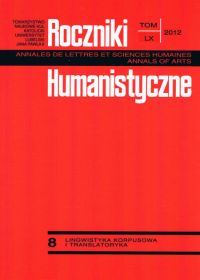From a Bitext to a Dictionary: Terminology in the Tourist Guidebook as a Source of Dictionary Equivalents
Abstract
A source of translation equivalents are texts, especially the so-called bitexts (i.e. the source text and its translation). In this study tourist guidebooks with a considerable amount of terminology mainly relating to architecture (sacred and secular), painting, religion, etc. served as the bitexts. The analysis of many tourist guidebooks made it possible to determine the corpus of terms of certain recurrence in various texts. A significant number of them do not appear in bilingual dictionaries. This justifies the need to supplement dictionaries with new terminological units, found in the analysed bitexts. The abovementioned recurrence facilitates finding new dictionary equivalents among terms through analysis of texts written by different authors and at the same time different translators. The identification of identical translations roves correctness and the accuracy of their choice.
Du guide vers le dictionnaire. Terminologie dans un guide touristique en tant que source d’equivalents lexicaux
Les textes, plus particulièrement les textes parallèles (l’original et sa traduction), constituent une source d’équivalents lexicaux. La présente étude s’intéresse aux équivalents lexicaux se trouvant dans des textes parallèles en prenant comme exemple des guides touristiques. Nous y avons noté un lexique terminologique considérable, notamment dans le domaine de l'architecture (sacrée et laïque), la peinture, la religion, etc. L'analyse de plusieurs guides touristiques a permis la constitution d’un corpus de termes qui se caractérisent par une certaine répétitivité dans de nombreux textes. Une grande partie d'entre eux n’existe pas dans les dictionnaires bilingues. Ce fait justifie la nécessité de compléter ces ouvrages de nouvelles unités terminologiques, extraites des textes parallèles analysés. La propriété de répétitivité rend l’établissement d’équivalents lexicaux plus facile à travers leur recherche dans des textes de différents auteurs et traducteurs. Le fait de remarquer les mêmes traductions permet de démontrer la justesse et la précision de leur sélection.
References
Bogusławski Andrzej, 1997, «Zagadnienie jednostek przekładowych» [w:] Współczesny język polski i rosyjski. Konfrontacja przekładowa, [red.] Bogusławski A., Mędelska J., Warszawa, Wydawnictwo Uniwersytetu Warszawskiego.
Bogusławski Andrzej, 1976, «Problem „tertium comparationis” w porównaniu lingwistycznym» [w:] Kwartalnik Neofilologiczny, XXIII.
Chlebda Wojciech, 2011, «Ekwiwalencja i ekwiwalenty: między słownikiem a tekstami» [w:] Na tropach translatów. W poszukiwaniu odpowiedników przekładowych, [red.] Chlebda W., Opole, Wyd. Uniwersytetu Opolskiego, 21-44.
Gajda Stanisław, 1990, Wprowadzenie do teorii terminu, Opole, Wyd. Wyższej Szkoły Pedagogicznej.
Jędrysiak Tadeusz, 2008, Turystyka kulturowa, Warszawa, Polskie Wydawnictwo Ekonomiczne.
Wawrzyńczyk Jan, 1997, Rosyjsko-polskie relacje przekładowe w praktyce leksykograficznej i w dziełach tłumaczy, Warszawa, Wydawnictwo Uniwersytetu Warszawskiego.
Copyright (c) 2012 Roczniki Humanistyczne

This work is licensed under a Creative Commons Attribution-NonCommercial-NoDerivatives 4.0 International License.





